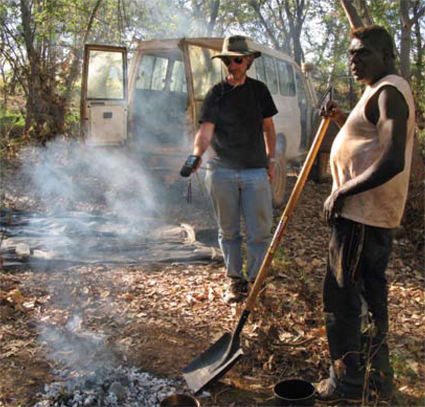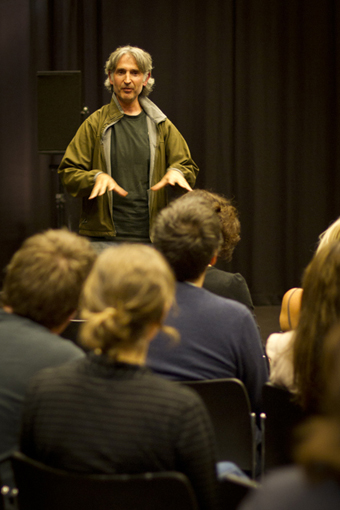water, wind, earth, fire
gail priest: philip samartzis, desert, thnmf

Philip Samartzis and Gabriel Nodea, field recording near Warmun
photo courtesy the artist
Philip Samartzis and Gabriel Nodea, field recording near Warmun
A FEW MONTHS BEFORE PHILIP SAMARTZIS WAS TO UNDERTAKE TURA’S REMOTE ARTIST IN RESIDENCE POSITION IN THE WARMUN COMMUNITY OF EAST KIMBERLEY, A FLASH FLOOD WIPED OUT THE TOWN AND ITS 400 RESIDENTS WERE EVACUATED TO KUNUNURRA. WHEN THE RESIDENCY RCOMMENCED THE COMMUNITY HAD ONLY JUST MOVED BACK AND WORK WAS UNDERWAY TO REBUILD THE TOWN. THIS HAS MADE SAMARTZIS’ PROJECT ALL THE MORE RELEVANT AS HE HAS SONICALLY DOCUMENTED A COMMUNITY IN THE PROCESS OF PHYSICAL AND SOCIAL RECONSTRUCTION.
Samartzis’ project is titled Desert, ironic now obviously as the area has greened up with the rain, but also as its isolated, wilderness connotations are shattered by the presence of much machine noise from the rebuilding process. Nevertheless Samartzis and his assistant Madelynne Cornish have treated this contrasting range of sounds with equal care and curiosity. The surround sound presentation at Totally Huge New Music Festival was a work-in-progress, as Samartzis begins the process of condensing the vast amounts of material and shaping it into a final work.
Given the circumstances it’s not surprising that the piece begins with water, a gentle fade-in that gradually envelops us in its flow. It’s not the roar of the flood but a reminder of water and its force. The presence of machines is introduced very early—part of the environment as much as the overarching sonic dome of insects, frogs, laughing birds and barking dogs. Large trucks drive past, or rather through us (the audience clustered in the middle of one of the underground studios of the State Theatre Centre, closest to the sweet spot); planes and helicopters fly low overhead; wind rips through trees making metal objects creak and clank.
Occasionally we are offered the voice of an older Indigenous woman, mixed with the metal clangs, so that we hear only the texture and warmth of her voice but not much of her meaning. She re-appears at the end, overlayed by cavernous thwumps of a water tank being hit and we can just make out phrases about “cleaning the water tank,” “tough old-man.” The only other human voices we discern as distant murmuring and chatter. It seems Samartzis wants to avoid recognisable speech, maybe for fear this might encourage a semantic listening, searching for the meaning and cause of the sounds. However as the sources of his landscape recordings are quite clear—we recognise birds, dogs, fire and insects—perhaps the shift to text might not impose such a rupture. While aware that this is not an attempt at text-driven documentary, it feels as though a little more sense of the people through their own voices and words may be beneficial.

Philip Samartzis discussing Desert, THNMF 2011
photo Brad Serls
Philip Samartzis discussing Desert, THNMF 2011
The quality, depth and clarity of Samartzis and Cornish’s recordings are absolutely breathtaking and the sense of immersion, particularly if you close your eyes, is total. Yet it’s a hyper-real world—all the natural sounds are larger than life, as if the insects and birds are five times the scale. We hear individual grains of campfire crackle as if we are, in fact, inside the fire. I imagine sci-fi scenarios of being shrunk down so I can observe life on a molecular level. I’ve not experienced this slippage between reality and fantasy in field recording-based pieces before. It’s utterly engaging and raises interesting questions around ideas of authentic representation and artistic intervention in the documentation of natural sounds.
A surprising highlight, particularly for the more industrially inclined, is the ‘metal machine music’ made by the range of construction going on in the town. (Samartzis cites Lou Reed’s album of the same name as a seminal influence in his early noise making days in the duo Gum; see Experimental Music in Australia, USNW Press, 2009, Ed Gail Priest.) Creaks, scrapes, cataclysmic clangs and whining power tools are deftly sculpted into almost rhythms and seeming songs, while never feeling artificially musicalised.
At the end of the residency in the community the project was presented as an installation in the Warmun Art Centre (from which, the curator Maggie Fletcher mourns, 1000 paintings were swept away in the flood). The performance presentation at Totally Huge is a 45-minute piece and while it loses some structural cohesion around three-quarters of the way through, it ends beautifully with the small sounds of running taps, water tanks and a final clang, perhaps the slam of a rusty gate. Samartzis will continue to work on the composition for further presentation and I look forward to its next iteration but for now our time in Warmun is over.






